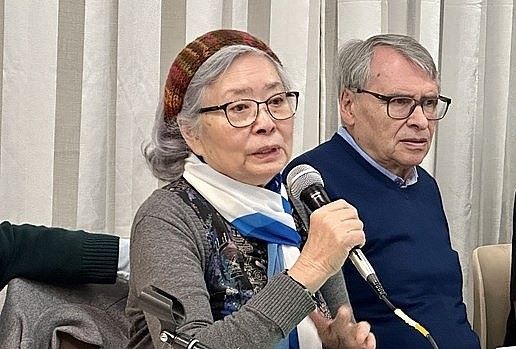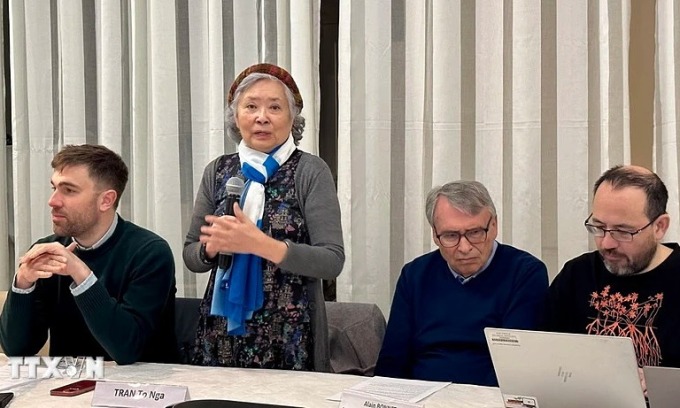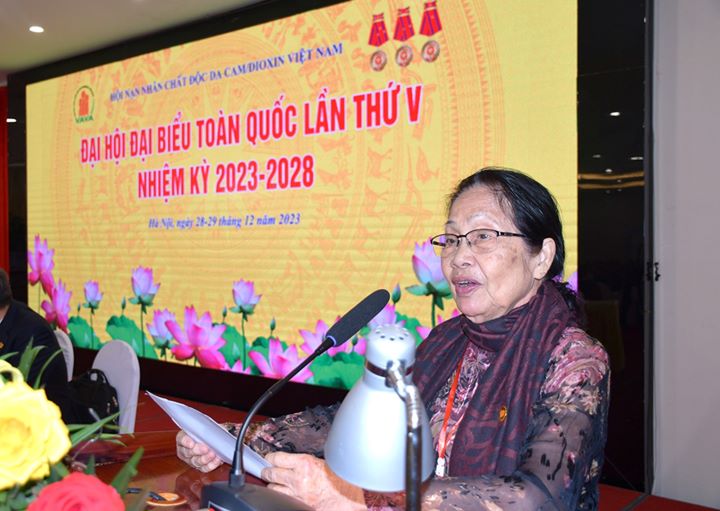
According to domestic and foreign researchers, the area of land sprayed with herbicides is about 3 million hectares; many natural ecosystems have been destroyed; many dense tropical forests with different vegetation layers have become bare hills and mountains; and many mangrove forests have been turned into wastelands. According to the investigations of the 10-80 Committee, Vietnam has 28 "hot spots" contaminated with toxic chemicals, including military air bases and airfields used by the US military in the spraying operations. In particular, the airbases of Bien Hoa (Dong Nai), Da Nang, Phu Cat (Binh Dinh) and A So (Thua Thien-Hue) are the areas with dioxin contamination concentration levels higher than limit, negatively affecting the environment and people in the short and long term. Researchers from Columbia University (New York - USA) identified that about 4.8 million Vietnamese people were exposed to Agent Orange/dioxin; millions of people are living in disease and poverty due to the sequelae of Agent Orange/dioxin. Many researches by domestic and international scientists have proven that Agent Orange/dioxin causes many diseases such as reproductive accidents, teratogens, deformities, malformations, and cancers. CS poisons and weapons and vehicles containing CS are stored in quite large quantities. Some are located in old warehouses and military bases, some are scattered in rugged forests, or buried deep in the ground. They are only discovered by people working in the fields or during the process of farming. The large amount of CS poisons and weapons and vehicles containing CS not only pollutes the environment but also affects the health of the community, hindering production activities. In some localities, bad guys also use CS poison to terrorize, threatening political security, social order and safety.
Being tasked by the Party, the State, the Central Military Commission, and the Ministry of National Defense to overcome the consequences of post war toxic residues, the Chemical Corps has actively and positively researched and provided scientific arguments, advised and proposed to the Party, State and Ministry of National Defense on guidelines, solutions, plans and programs; proposed the feasible technologies and international cooperation in overcoming the consequences of post-war toxic chemicals, and achieved many important results. Since 1996 to date, the Corps has carried out 20 projects and tasks to treat residual toxic chemicals after war. The investigations have identified contaminated sites of residual CS toxic substances in 293 districts, towns of 34 provinces and cities; collected and thoroughly treated over 460 tons of CS poison, hundreds of tons of weapons and vehicles containing CS poison, over 85 tons of other ammunition, and cleaned 1,375m3 of contaminated soil; develop a digitized map of detected and treated toxic residues, serving as a basis for authorities at all levels to make policies for local socio-economic development, defense and security; investigated, surveyed and assessed the level of Agent Orange/dioxin contamination at the airports of Tan Son Nhat, Bien Hoa, Da Nang, Phu Cat, A So, Nha Trang, Tuy Hoa, Phan Rang...; handled more than 220,990m3 of soil contaminated with Agent Orange/dioxin at Bien Hoa, Da Nang and Phu Cat airports; monitored technology to treat 94,593m3 of soil contaminated with Agent Orange/dioxin by In-Pile Thermal Desorption (IPTD) technology at Da Nang Airport invested by the Air Defense - Air Force. Currently, the Corps is accelerating the treatment of about 35,000m3 of dioxin-contaminated soil at A So airport. In parallel with the implementation of projects on investigation and treatment of residual toxic chemicals, the Corps also carried out four research projects to select technologies to treat toxic chemicals and dioxins and apply them in the treatment of "hot spots" contaminated with Agent Orange/dioxin. In addition, the Corps also cooperated with the Central Committee of Vietnam Association for Victims of Agent Orange/dioxin (VAVA) to conduct many propaganda activities about the Agent Orange/dioxin disaster and the remedial work; hold scientific seminars, exchange information, scientific research and coordinate in implementing projects and tasks related to victims of Agent Orange.
The Corps’ results in handling residual toxic chemicals after the war have made great contributions to the country's economic, political and social development, and strengthening people's confidence in Party, State and Army. It has made overall assessment of the pollution situation of toxic chemicals in localities, especially in important strategic areas; step by step decontaminate and restore the environment, protect public health, and contribute to realizing the goal of basically solving the consequences of chemical weapons used by the US on the environment and people in Vietnam. Improve the investment environment, increase the efficiency of land use, help localities promote socio-economic development and strengthen national defense and security. Provide highly reliable survey data as a basis for the Party and State to have appropriate development policies. At the same time, affirming the efforts of chemical troops to overcome difficulties and danger to act as the core force along with other departments, branches, localities and forces in the area affected by toxic chemicals, creating synergy in task performance. The forces participating in the projects and tasks to overcome the consequences of toxic chemicals are increasingly challenged with political steadfastness, high professional level, and readiness to receive and complete all assigned tasks.
Although the Party, State and Ministry of National Defense have had many policies and solutions to overcome the consequences of Agent Orange/dioxin and obtained many important results, they have only partially settled the serious consequences of the chemical war caused by the US to the Vietnamese people. According to the reports of the international scientific conference on "Diseases related to Agent Orange/dioxin exposure in Vietnam - Current status and solutions to improve the effectiveness of prevention and treatment", currently, dioxin content in soil, sediments in sampling areas are basically below the threshold limit. However, the total amount of soil and sediment contaminated with dioxin is estimated to range from 408,500m3 to 495,300m3 at Bien Hoa airport; about 67,974m3 in Da Nang airport, and about 35,000m3 in A So airport. In particular, contaminated soil and sediment in Phu Cat airport has been treated by landfill technology, however, they need to be thoroughly treated with appropriate technology when available. On the other hand, because of the high pollution concentration, the large amount of contaminated soil and sediment, treatment is very costly. Landfill technology only prevents dioxin from spreading to the surrounding environment.
Therefore, thoroughly handling Agent Orange/dioxin-contaminated areas, especially in "hot spots" is an urgent task, requiring the cooperation and involvement of all levels, sectors, and the political system and the whole people, in which the Chemical troops need to promote its core role and drastically and synchronously implement many solutions in both immediate and long term.
First of all, the Corps should continue to thoroughly grasp and effectively implement the guidelines and policies of the Party, the State, the Central Military Commission, and the Ministry of National Defense on the work of overcoming the consequences of the remnants of the post-war toxic chemicals, focusing on Directive No. 43-CT/TW dated May 14, 2015 of the Secretariat (XI term) on strengthening the leadership of the Party in dealing with the consequences of the toxic chemicals used by the US during Vietnam War; Decision No. 2887/QD-BQP dated July 28, 2014 of the Minister of National Defense approving the “Strategy for environmental protection of the Ministry of National Defense until 2020, with a vision to 2030”; National program on combating climate change in the Army and "Strategy for environmental protection of the Ministry of National Defense to 2030, with a vision to 2050"; Directive No. 05/CT-BQP dated February 3, 2017 of the Minister of National Defense "On the implementation of projects and programs to overcome and handle toxic chemicals in the Army".
Actively and proactively advise, propose, build and complete relevant legal documents, ensuring the uniformity and consistency which review and perfect standards and regulations on monitoring, assessment and treatment of Agent Orange/dioxin towards ensuring safety for human health and the environment, in accordance with international regulations and specifics on Agent Orange/dioxin pollution in Vietnam. At the same time, promote propaganda activities, raise awareness and responsibility of all levels, sectors, officials, soldiers and people to proactively prevent exposure and minimize negative impacts of toxic remnants, contributing to stabilizing political security, social order and safety, economic and cultural development, and improving the quality of life. Coordinate with VAVA to conduct propaganda about the Agent Orange disaster and the concern and care of the Party committees, authorities, people and the Army for AO victims.
Implement projects and tasks to overcome the consequences of toxic residues after war and protect the environment in accordance with the objectives, contents and scale of investment. Accelerate the treatment of Agent Orange/dioxin in "hot spots'', continue to investigate, evaluate, locate, control and handle newly discovered contaminated areas. Implement the project of "Treatment of dioxin-contaminated soil at A So airport (A Luoi, Thua Thien-Hue)" invested by the Chemical Corps; direct the National Action Center for Toxic Chemicals and Environmental Treatment (NACCET) to closely coordinate with ministries, branches and localities to implement projects to support the improvement of the quality of life for disabled people in 8 provinces heavily sprayed with Agent Orange (funded by the United States Agency for International Development - USAID). At the same time, control and warn of exposure risks to humans and the environment, and prevent the increase of victims in polluted areas.
Train, foster, select and build a team of capable cadres and experts in the field of handling toxic residues after war and master and transfer technology to treat environmental pollution in the direction of synchronicity, sufficient quantity, and improved quality. Formulate mechanisms and policies on recruitment, use and treatment of science and technology staff; create motivation and offer practical benefits to promote the creativity of scientific researchers; apply special and appropriate remuneration mechanisms and policies for individuals with outstanding achievements in science and technology activities, encourage, create an environment and motivation for young officials, scientists and researchers in research and application of scientific and technological achievements in performing the task of overcoming the consequences of chemical pollution and protecting the environment. Along with that, pay attention to the modernization of NACET. Modernize equipment and technology for dioxin sampling, analysis, research, treatment and monitoring. Acquire and master equipment under the project "Receiving dioxin and environmental analysis equipment funded by the Japanese government".
One of the important issues in overcoming the consequences of postwar residual chemicals is the treatment technology with the requirements of cost and labor effectiveness, suitability to the specific conditions of our country. On the basis of major orientations of the Government and the Ministry of National Defense on research and application of technological solutions for residual chemicals treatment, it is necessary to continue to conduct research, test, and select the technologies for radical treatment of Agent Orange/dioxin in soil and sediments suitable for Vietnam conditions. Currently, a number of dioxin treatment technologies have been tested and applied such as sequestering landfill technology, biotechnology, New Zealand's mechanical chemical decomposition (MCD) technology, TCH technology, specifically the IPTD system… In 2021, the Shimizu Corporation of Japan coordinated with the Center for Environmental Treatment Technology (under Chemical Command) to carry out a pilot project to treat Bien Hoa soil with soil washing technology. Test results of washed soil show that dioxin content reaches QCVN 45 for urban, recreational and commercial land. In addition, samples of soil, water, and air around the treated area are also analyzed and evaluated to ensure safety during and after testing, without adversely affecting the environment and people at the test site and surrounding area. However, each technological solution has different advantages and disadvantages that need to be further tested and evaluated in order to perfect the technology to be widely applied in thoroughly treating contaminated soil and sediment in large volume and with very high complexity in our country today. Cooperate with Shimizu Corporation (Japan), Cepthemodyne Group (USA) and Heamer Technoloy Company (Belgium) to test dioxin treatment technology at Bien Hoa airport; at the same time, continue to propose testing technology to thoroughly treat dioxin-contaminated soil with partners in order to find feasible technologies suitable to Vietnam's conditions.
The overcoming of the consequences of residual toxic chemicals after war not only depends on the efforts of the Corps, but also relies on the support and help of the international community. Therefore, it is necessary to promote international cooperation in the field of Agent Orange/dioxin handling, in order to continue to study the effects of the herbicides used by the US Military during Vietnam War on the environment and human health; exchange experiences on Agent Orange/dioxin decontamination; mobilize resources in science and technology, finance, human and strengthen and upgrade facilities for toxic research, analysis and detoxification technology. Seek financial and technological supports from the United Nations Development Organization (UNDP), the United States Agency for International Development (USAID), the Ford Foundation, the Atlantic Philanthropies Foundation, the Bill and Milindagatcs Foundation, JAC US- VN foundation, GEF foundation and many other non-governmental organizations to implement programs and projects to overcome the consequences of Agent Orange/dioxin in Vietnam.
Overcoming the after-war consequences of residual toxic chemicals is an urgent, regular, long-term task with profound humanitarian significance. With political responsibility and professional expertise, and increasingly modern equipment, the Chemical Corps will fulfill its key role in dealing with residual chemicals after war, making an important contribution to the development of the country./.
Major General Ha Van Cu
Commander of the Chemical Corps



_thumb_720.jpg)








_thumb_720.jpg)




















Comment